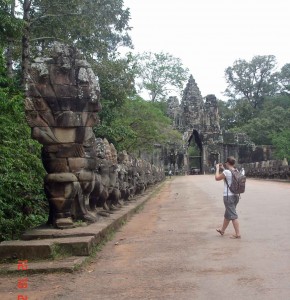
Seven-headed Naga,Gods and demons (asuras) line causeway
The Angkor Archaeological Park – Siem Reap
Few people realize when they visit Cambodia to see Angkor Wat, that Angkor Wat is only part of the Angkor Archaeological Park. The Archaeological Park has many Khmer temple ruins dating from the 9th-15th century. Very little other evidence remains of the ancient civilizations. Palaces and houses built of timber have long since disappeared. Temples considered the most important and sacred of buildings in the cities, constructed from stone for strength and lasting durability.
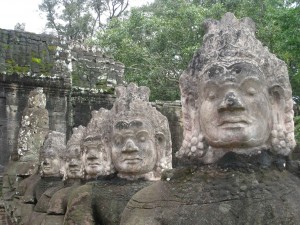
Ancient faces of Gods or Kings – approach to Angkor Thom
Capital of the Khmer Kingdom
Angkor Thom is the first of five ancient sites we visited in the Angkor archaeological Park at Siem Reap.
Angkor Thom, built in the Bayon style late 12th century during the reign of King Jayavarman VII. Angkor Thom is believed to be one of the largest Khmer cities founded by Jayavarman VII, and the capital of the Khmer kingdom until the early 17th century. The city, enclosed within a square has 8 meter high walls covering 12 km in length, reinforced with an earthen embankment on the inside; on the outside surrounded by a wide moat. It is a fortified city and spreads over 10 sq km. Each of the four walls has a central gate at directional points N,S,E and West. A fifth gate known as the victory gate is on the east wall of the city. The gates made from stone blocks, stand 23 meters high, have triple towers with four faces carved on each side of the tower.
Elephant heads jut out from the gate wall either side of the entrance. The elephants have huge trunks which are their most distinguishable feature and seem to be pulling out lotus flowers.The elephant represents Airavatar the three-headed elephant, mount of the god Indra. Indra is god of the sky and king of the gods in the Hindu religion.
South Gate – Faces
The South Gate is on the road from Angkor Wat and Siem Reap, and is the most common entry point for visitors. The approach to the gate lined by an avenue of statues, figures on the left are gods, those on the right are fierce-looking demons or asuras. Many of the gods and demons are headless, some have had recent replacement heads (head transplants). The original heads and faces are impressive. The gods and demons seem to be supporting the body of a giant serpent, a seven headed Naga (like the Naga balustrade at Wat Banan and other temples). Over time the body of the serpent broken in many places and pieces missing. The face on the South gate is almost indistinguishable until you get close to the entrance. The faces on all five towers thought to resemble the likeness of King Jayavarman VII.
On entering the grounds the reverse of the entrance gate is the same inside as out, but smiling faces and elephant heads more distinguishable. The south gate entrance is the most complete of the four gates, gods, demons and naga balustrade are sadly lacking from the other entrances.
The complex of temples and sites within Angkor Thom is huge, temples built by various Kings over the centuries now in varying stages of ageing and decay, each fascinating in their own right. The stones, roofs and lintels covered in bright green moss or silvery-grey lichen adding to their beauty and intrigue.
Angkor Thom also holds older monuments from earlier eras built by different Kings, not just the temples built by King Jayavarman VII and his successors. Giant smiling faces follow you from the Gates of Angkor Thom to the State temple or the Bayon in the center of the city. To the north, near Victory Square other major sites are found; the Baphuon, Phimeanakas, Elephant Terrace, and Terrace of the Leper King.
It is only a short walk down the road to visit the State Temple of Bayon. It lies within the city walls of Angkor Thom.
Important Information:
Purchase of an “Angkor Pass” is essential to visit the temples and sites in the Angkor Archaeological Park. Passes to be purchased at the main entrance on the road to Angkor Wat.
Passes sold in one-day ($20), three-day ($40) and seven-day ($60) blocks to be used on consecutive days. An individual photo taken when you buy a pass. Carry this pass with you. Passes checked on park entry and at major temples. Hefty fines incurred for not possessing a valid pass inside the Archaeological Park.
Visiting hours are 5:00am – 6:00pm. Closing times can differ for some temples. Check when you buy your “Angkor Pass”.
Related Posts:
- lake tonle sap floating villages
- Sankae river boat cruise stung sangkae river
- Wat Banan Battambang Province
- Sightseeing by tuk tuk the province of Battambang
- fun in the sun rural countryside battambang province
- fast and furious ride on a bamboo train cambo dia
- potters pots and pottery the province of chhnang cambodia
- Udong Stupas – intriguing burial sites
- Garment factory workers in the rain Phnom-Penh
- Kompong-speu waterfall area Kirirom national park
- verdant green pine forest kirirom national park
- traditional music pich nil cambodia
- spirit houses pich nil mountain pass
- golden lions of Sihanoukville beach resort town
- Highway to Sihanoukville town deep sea port and beach resorts
- durian tropical fruit Kampot-landmark old bridge
- plantations of black pepper-salt and pepper Kampot
- Beachhouse at Kep – Seaside resort
- Caves of kampong trach kampot caves
- Tonle (lake) Bati – Hindu Temple of Phnom Chisor
- Temple of Ta Prohm Takeo
- A Mekong cruise on the mighty Mekong River
- Killing fields – Cambodia – a chilling experience
- Tuol Sleng Genocide Museum Phnom Penh Cambodia
- Lotus Blanc- Phnom Penh- Restaurant
- Artifacts – National Museum of Cambodia Phnom Penh
- Emerald Buddha Silver Pagoda Phnom Penh
- Royal Palace Throne Hall Phnom Penh
- Cambodia 2011 Phnom Penh city
- Snapshot of Cambodia Kampuchea
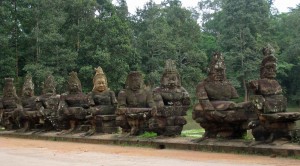
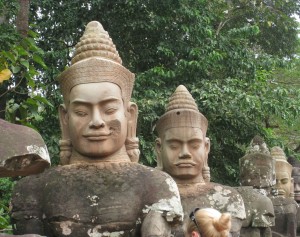
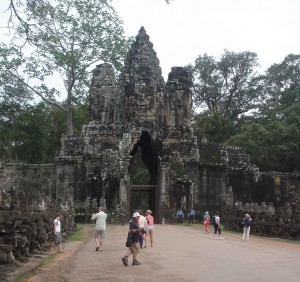
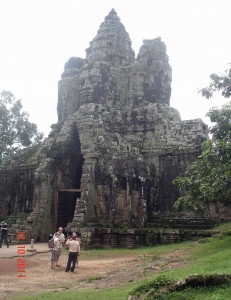
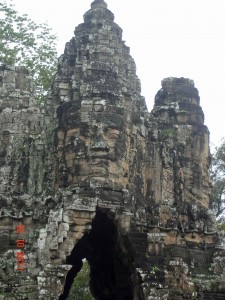
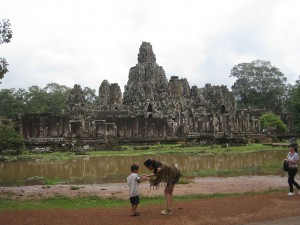
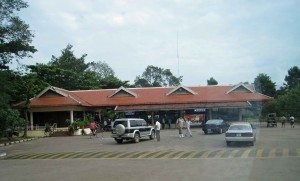
Interesting post, Lyn. I didn’t realize Angkor Wat was such an extensive complex. All the faces and sculptures in this site make it easier to relate to than sites that have only blank walls — though I wonder how much of what we’re seeing is original and how much has been restored.
Hi Paul,I believe most of what we are seeing is still original. Many temples have areas that are just a stone floor with adjacent piles of stone and rubble. Restoration of some areas is happening now since Angkor became a world Heritage Site in 1992.A small section of the Bayon under restoration when we were there. In Tokyo 1993 an International Coordinating Committee was established to oversee restoration of Angkor in conjunction with UNESCO.Angkor is a fascinating place, many temples are in total ruin, covered in the brightest green moss, not touched for hundreds of years. An amazing place to visit.